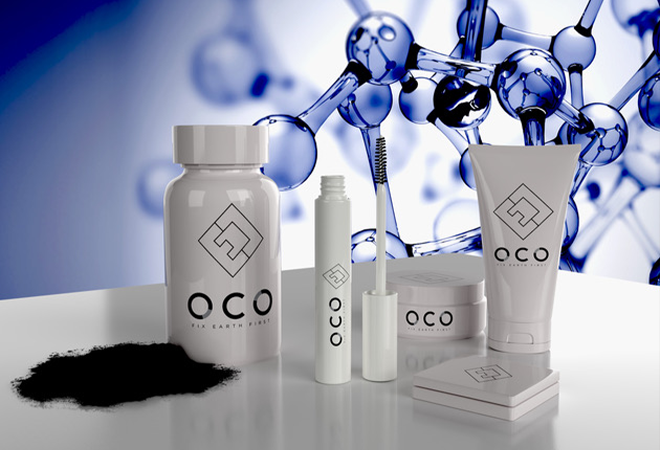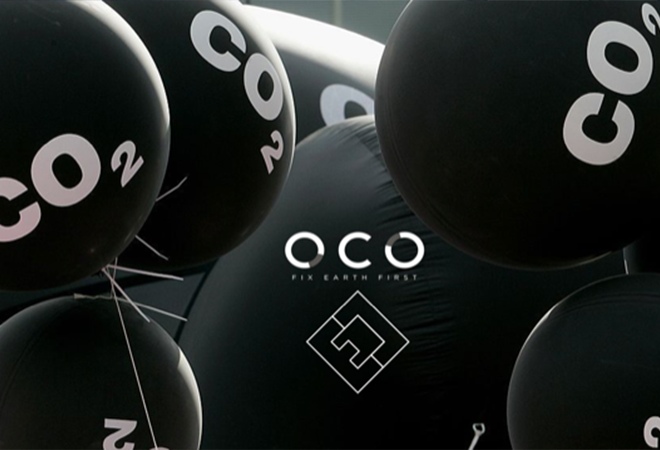With many of the industry’s current endeavors to reduce plastic underway, Element and Oco have taken their mission a step further, partnering on captured carbon packaging, ready for market, which works with the recycling system’s current handicaps, rather than against it.
Ulrich Lerissel and Nick Gardner founded Element in 2017 to bring change to the B2B packaging and consumer goods supply industry. “We had both run big companies but, when we partnered, we felt it was hugely liberating to be free of the tiresome model where everything we designed needed to be built in China and then imported to the US,” Gardner states. In a bid to lessen our carbon footprint, Element, which works across the color cosmetics, beauty, skincare, wellness, and home care industries, has incorporated sustainable materials into its client solutions. Element is also a founding member of Pact, the nonprofit initiative that joined forces with Credo Beauty, MOB Beauty, Sephora, and Hudson’s Bay to tackle waste in the beauty industry.
Oco was founded by Madison Savilow and Peter Zhou, employees at Canadian carbon utilization company Carbon Upcycling Technologies, who wanted to bring their innovations to the consumer product market, making them frontrunners in the captured carbon emissions CG (consumer goods) bracket. To date, they have developed over 300 carbon dioxide–enhanced materials using gaseous carbon dioxide and inorganic powder as their feedstocks, which allows carbon dioxide to be permanently stored within the powder, thus creating a high-performing and easily integratable end material. Oco’s mission of creating a net benefit, rather than net neutrality, also aligns with Element’s mission to do better with what we have, rather than trying to bring a completely new product to market.
Together, the two have created carbon-capture packaging that is both easily recyclable, but more importantly, that, when (not if) it ends up in a landfill, has captured, and won’t release, CO2. To date, Oco and Element have partnered on LDPE (low-density polyethylene) material for tubes, polypropylene for mascara components, and HDPE (high-density polyethylene) for food and supplement packaging. The companies decided to work on these materials instead of PET (polyethylene terephthalate), as said plastic already has a leading recycling stream in comparison to its counterparts in the US. The secret ingredient is Oco’s patent-pending additives for PCR (post-consumer recycled) resins, including PP (polypropene), HDPE, LDPE, and PET, made of fully sequestered carbon while also increasing durability, recyclability, and material performance.
The refreshingly realistic concept was born from the idea that a product is likely to end up in landfill, a stark reality of the current recycling state. After all, once the product is in the hands of consumers, even the greatest environmental efforts are nullified when their compostable/recyclable/biodegradable packaging is simply thrown in the trash. Add to that the finite number of recycling opportunities, the lack of infrastructure and facilities, and it all adds up to: recycling doesn’t guarantee actual recycling.
Instead of creating new plastic, which occurs even when producing its eco-friendly alternatives, Element is using high levels of post-consumer waste, ocean-bound plastic, PCR, and PIR (post-industrial recycled)—in short, plastics that are already in circulation. The company is also passionate about eliminating single-use products, which is where Oco’s additives are instrumental in improving lifespan.


“We can upcycle post-consumer waste and increase performance of the material by integrating our CO2 enhanced powder additive. We improve tensile strength, longevity, and durability of the plastic waste. We do more than carbon utilization; we’re a circular materials company,” Savilow states. “We're upcycling waste instead of introducing new virgin materials to the world.”
Bringing these efforts to the wider industry is a crucial step in making environmental progress and driving change. “Partnerships with innovative companies, such as Element, provide an incredible opportunity to utilize waste materials, like ocean-bound plastics, in high-value consumer goods. At Oco, we’re dedicated to improving the environment by creating carbon sinks out of these products through permanent sequestration of carbon dioxide,” Savilow explains.
Recycled and recyclable plastic has been a talking point for some years now, but the end of lifecycle—the recycling facilities, how consumers dispose of their products, the infrastructures underlying these very mechanisms—appears to be less discussed than material innovation. Although Element and Oco’s partnership is built on transforming the material itself, they are also taking into consideration what happens once the object in question leaves their facilities.
“Plastics, if they are correctly sorted, placed, and mixed into a stream of plastic that is essentially the same, can be reused. The main problem and the reason why most things don’t get recycled, certainly in the beauty industry, is thof the pieces that we produce because of volumes and fills,” Gardner states. When a packaging component doesn’t match the size requirements of the material recycling facilities (MRF), it is impossible to recycle. “That's something we need to also educate the consumers on. We're being very transparent about the fact that, if this is going through a municipal recycling facility, it's likely to end up in landfill anyways,” Savilow adds. “All of our materials can be recycled through industrial recyclers and it does have some properties where it can even benefit that process. But unfortunately, a lot of the cosmetic packaging isn't going that route.”
Using their polypropylene mascara component made of PCR as an example, Gardner notes: “We're acknowledging the system constraints. Because of its physical size, it will not be picked up by any recycling systems that are currently available in the US or Canada. They just don't exist. When they [these facilities] were built, mostly in the 50s, they were designed to look for glass and aluminum, not recyclable plastics.” Furthermore, recycling rates in the US are particularly low. According to a report by the Organisation for Economic Co-operation and Development, recycling rates in the EU average 30% while those in other high-income countries are around 10%.
“We're working on the assumption that it will, with a 90% chance, end up in landfill, because that's the odds. If it were in California, it would be 94%. We're dealing with a horrible reality, but trying to make the best of a bad situation,” Gardner explains. “In the inevitability that our product ends up in landfill, what it will have done is trapped carbon from entering the atmosphere and it will be inert. It will be better waste plastic sitting in a landfill with all of the other mostly virgin plastic.”
While virgin polypropylene is being abandoned by a large part of the industry to meet carbon neutrality targets, Gardner warns that “the PCR supply chain is not great,” and therefore enhancing these materials to perform better and be more reusable may actually be a more sustainable solution than doing away with them altogether, if they are already in circulation, that is.
Even if there were to be radical change in the recycling system overnight, Element and Oco are confident their product will still stand the test of (sustainable) time. “Let's say that the waste industry completely changed in the next five years, if all the money the government set aside to alter the environmental situation in the US was put into MRF—new machines, better collection systems, more computers—we have still created a better waste material that can be recycled more times,” Gardner proclaims.
One thing is for certain: it’s only the first chapter in Element’s and Oco’s mission to offer total transparency and immediate solutions to our recycling dilemma for the here and now, rather than in a few years’ time.